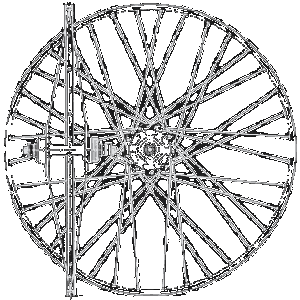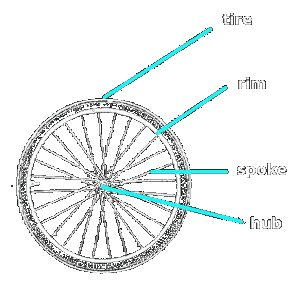The bicycle wheel has been one of the lightest and strongest structures in design and engineering for over a century. So it’s good to know, while bowling along on your bicycle, what experience and know-how has gone into this apparently simple device.

Your local bike shop will sell bikes with wheel sizes from 12″/300mm to 29″/700C depending on use. Children’s bikes sizes are defined by the size of the wheels. Adult bikes, whether extra-large or extra-small are limited to two or three standard sizes of wheels. It’s the frame size which makes the difference.
If you’re buying a new bike, is wheel size a consideration? Here’s a run down on wheel sizes and their applications:
12″ : Used on the smallest children’s bicycles and balance bikes.

16″ : Intermediate children’s bicycles bridging the gap between bicycles with training-wheels and free-riders.
20″ : For free-riding youngsters, although training-wheels can be fitted so some models. This wheel size is also used on some adult folding bicycles.
24″ : The largest wheel for children’s bicycles. Most 24″ wheels conform to a mountain bike type, that is, tires about 2″/50mm wide. Some very small adult cycles also use this wheel size.
26″ : The smallest true adult wheel size and originally developed for the first manufactured mountain bikes around 40 years ago. As well as mountain bikes this wheel can be found on some hybrid bicycles and cruisers. Most 26″ wheels are made for a tire width of around 2″/50mm+. If you want to adapt your old mountain bike for on-road/commuting use you can fit a slick tire less than 1.5″/35mm wide for less rolling resistance on the road.
The 26″ wheel has variations so that an old Schwinn 26″ wheel is a different size which can make for problems with replacement tires.
650 : Sometimes known as 27.5″ and originally a wheel designed for French utility and touring bicycles, there are 650A, -B and -C variations which have different rim diameters. This wheel – 650B – is at the forefront of a new generation of mountain bikes, bridging the gap between 26″ wheels and 29″ wheels. Expect to see bikes with this size wheel in the next year.
27″ : A once universal, but now obsolete wheel size, usually only found on classic ten-speeds and English three-speeds. A limited range of tires are still available.

700C : A virtually universal standard for lightweight road bikes, this wheel is also used by hybrids designed for predominately road use. These wheels have the least rolling resistance of any bicycle wheel.
29″ : A comparatively recent standard for mountain bike wheels, the rims were developed from 700C road wheels. This size wheel offers superior rolling ability over rough terrain.
Smaller riders may need to look at 26″ wheel mountain bikes for a good fit, although the introduction of the 650B will widen that choice.
There are one or two wheel sizes which are not standard. These include 14″ and 18″ wheels. These are found on big box store toy bicycles. Customers are often shocked by the price of wheels we supply to replace bent and broken children’s bike wheels, often because a properly manufactured and safe, quality wheel will cost more than the original toy bike.
We will only sell you a product we know will not fail.
If you’re seeking information on other topics click on any item in Halter’s Tag Cloud in the right hand column of this blog …
Alan – That British Bloke








